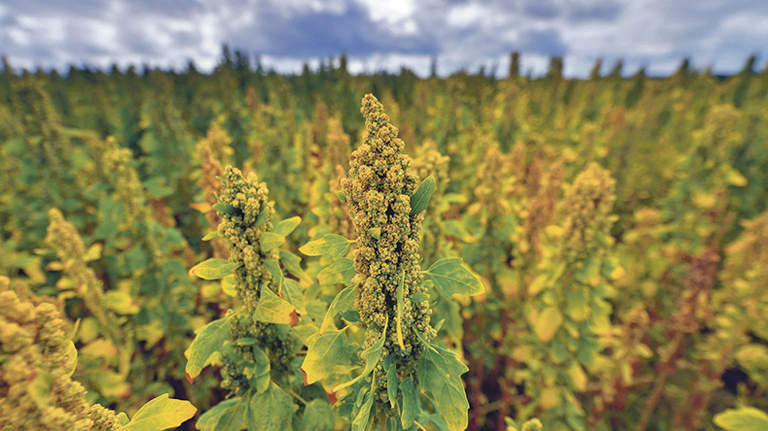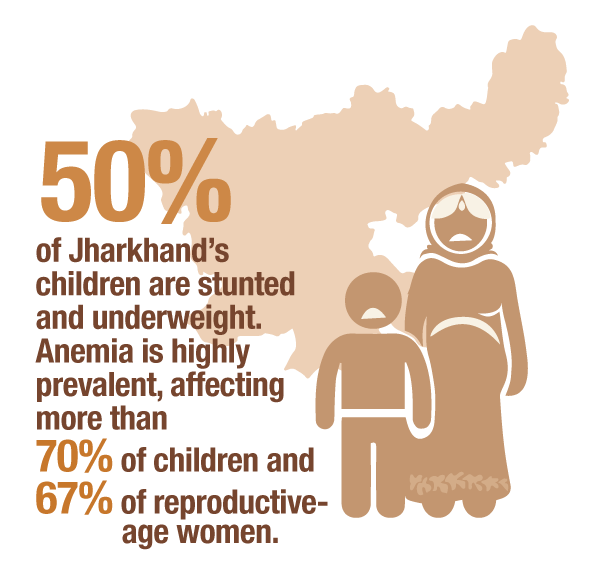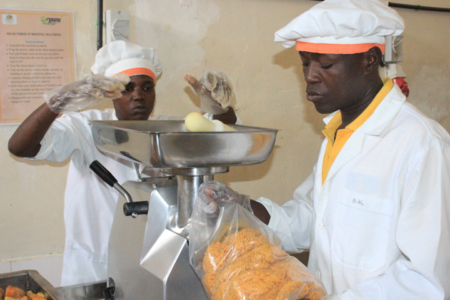
Introduction of biofortified, orange fleshed sweetpotato and new varieties of quinoa will improve child and adult nutrition, boost food security, and generate sustainable incomes in Jharkhand, India.
Background
High rates of child malnutrition persist throughout India and Jharkhand in eastern India has some of the worst statistics in the country. Around half of Jharkhand’s children are stunted and underweight. Anemia is highly prevalent, affecting more than 70% of children and 67% of reproductive-age women. Improved sweetpotato and quinoa would be appropriate here as they are highly nutritious, climate-resilient crops that have great potential to improve nutrition, food security and incomes, particularly among the rural poor.
While currently only a minor crop in Jharkhand, orangefleshed sweetpotato (OFSP) fits well with current agroecologies and its production could be greatly expanded. It has a high fiber content and a low-to-medium glycemic index under most preparation methods. OFSP is also rich in vitamin A, while purple-fleshed sweetpotato contains beneficial antioxidants. Sweetpotato leaves also provide a good source of dietary minerals, including iron, folate (vitamin B9) and manganese.
Sweetpotato also tolerates dry conditions and is less susceptible to pests and diseases than many other vegetables. Work by the Indian Council for Agricultural Research and the Central Tuber Crops Research Institute (CTCRI) has shown that high-yielding sweetpotato varieties can perform well in the state.
Meanwhile, quinoa is gluten-free, has a low glycemic index, and is rich in all nine essential amino acids as well as iron, calcium, magnesium and potassium. Newly introduced in India, quinoa is proving a useful addition in drought-prone areas with high soil salinity and low temperatures. Both crops would complement the existing predominantly rice based production systems.
Objectives
- To accelerate social and economic development in Jharkhand through the inclusive and sustainable growth of the agri-food sector, starting with high potential zones; and
- To establish profitable and sustainable value chains for sweetpotato and quinoa capitalizing on growing demand for nutritious food and feed
Approach
The project team will identify suitable areas for introducing and disseminating sweetpotato and quinoa using geographic information systems and remote sensing, combined with qualitative surveys of farmers and other value chain actors. The maps generated will aid the precise targeting of crops to low-production and/or poverty-prone areas.
Working with researchers from the International Potato Center (CIP), Birsa Agriculture University (BAU), and the International Center for Biosaline Agriculture (ICBA), farmers and other end-users will evaluate high-yielding sweetpotato and ICBA-developed quinoa varieties. Orangefleshed sweetpotato will simultaneously be assessed for suitable qualities for processing into flour and puree.
CIP training materials will be adapted to provide best practices to farmers on managing soil, water, weeds, pests, and planting materials.
Through the introduction of the ‘small farmers, large field’ (SFLF) model, farmers will benefit from economies of scale by pooling their holdings into fields of 50–500 ha for sweetpotato and 10–20 ha for quinoa. By synchronizing farming activities, individual farmers will benefit from lower unit costs for quality seed, seed storage, machinery use, and field operations. The SFLF approach will be tailored to the needs of the specific farmer groups involved, including accommodations for gender differences where appropriate. Researchers will also look into crop rotations and intercropping to help sustain productivity gains and reduce chemical inputs.
Once sweetpotato varieties are selected, the team will support the establishment of small businesses for multiplication and marketing of quality planting materials. Though these often emerge from among the project farmers, they may also involve established horticultural nurseries. The project will provide training and basic infrastructure to multipliers and facilitate their access to certified sources of clean planting material from CTCRI or elsewhere.
Moreover, selected farmers and farmer-producer organizations will receive access to processing equipment and hands-on training in quinoa seed production and processing. After crop varieties are released, Birsa Agricultural University may operate as a breeder and foundation seed producer, with certified seed produced by public and private seed companies. The farmer-producer organizations and trained farmers will also become seed entrepreneurs, catalyzing community seed bank development locally.
Market linkages with processors and traders will be created and improved via the ‘participatory market chain approach’. The approach seeks to generate market-oriented production strategies, profitable enterprise opportunities along the market chain, and employment generation for young people. As such, value chain actors will be able to jointly identify, analyze and benefit from potential business opportunities. The approach will be complemented by demand creation through raising public awareness of the health benefits of sweetpotato and quinoa.
To forge additional links and lay the foundations for scaling up, state-wide sweetpotato and quinoa networks will be established, comprised of schools, scientists, extension specialists, government officials, food processors, and farmer representatives.
Expected outcomes
This project will demonstrate the technical and economic feasibility of expanding sweetpotato and quinoa production and utilization in Jharkhand. While outcomes and impacts will be local, the changes in knowledge and motivation achieved will lay the foundation for rapid scaling out of promising technologies and investments.
Key outputs
| Key outcome | Targets |
| Farmers cultivating sweetpotato | 5,000 |
| Additional income from sweetpotato | USD 210/ha |
| Increase in sustainable production of sweetpotato | 10,000 tons |
| Farmers in drought-prone areas cultivating new varieties of quinoa | 500 |
| Area dedicated to quinoa production by 2022 | 200 ha |
| Quantity of quinoa produced by 2022 | 400 tons |
Contact
Umesh Singh
CIP, India
u.s.singh@cgiar.org
Thanks to our donors





